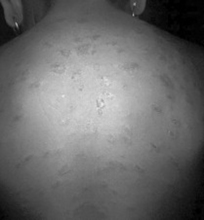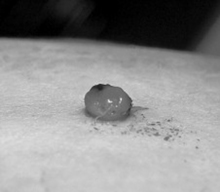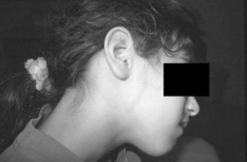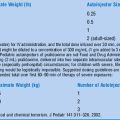CHAPTER 21 Pediatric Rashes
1 Name five bioterrorism agents that may have skin manifestations.
TABLE 21-1 BIOTERRORISM AGENTS THAT MAY HAVE SKIN MANIFESTATIONS
| Agent | Skin Findings |
|---|---|
| Smallpox | Maculopapular rash on face, forearms, and mucous membranes that becomes vesicular/pustular within 48 hours |
| Anthrax | Painless pruritic papule on skin that develops into a painless, ulcerated black eschar within a few days |
| Tularemia | Painful maculopapular lesion that ulcerates; associated with papular painful inflamed regional lymph nodes |
| Plague | Acutely swollen lymph nodes called buboes |
| Viral hemorrhagic fever | Maculopapular rash on trunk followed by mucosal bleeding |
eMedicine: Dermatologic Aspects of Bioterrorism Agents. Available at www.emedicine.com/derm/topic905.htm#section~viral_agents.
2 What are four skin findings associated with syphilis?
| Chancre | Painless ulcer of skin and mucous membranes at site of inoculation |
| Rash | Maculopapular rash of secondary syphilis frequently involving palms and soles |
| Condyloma lata | Cauliflower-appearing warts on penis, labia, or rectum |
| Gumma | Painless pink to dusky red nodules of various sizes that may necrose or ulcerate |
Sexually Transmitted Disease. Syphilis pictures. Available at http://herpes-coldsores.com/std/syphilis_pictures.htm.
4 An atopic child with chronic eczema suddenly develops a painful, vesicular eruption in previous areas of eczema. What is the most likely diagnosis?
6 Differentiate between erythema multiforme (EM), Stevens-Johnson syndrome (SJS), and toxic epidermal necrolysis (TEN).
8 A child helps his mother cut limes before going outside to play and then returns with inflamed hands that quickly develop hyperpigmentation. What is the name of the rash and the causative agent?
9 What are the typical features of pityriasis rosea?
Seen primarily in adolescents, pityriasis rosea begins in 80% of patients with a large, oval, solitary lesion known as a herald patch somewhere on the trunk or upper thighs. This is followed by an eruption of smaller, oval, and slightly raised papules that are pink to brown and have peripheral scales. The lesions are described as having a Christmas tree pattern on the back and involve mostly the truncal areas (Fig. 21-1), usually sparing the face, scalp, and distal extremities. Eruption is prolonged and can last 4–8 weeks.
10 List key features that help differentiate the purpuric rash of Henoch-Schönlein purpura from more serious infectious purpuric rashes, such as purpura fulminans.
| Henoch-Schönlein Purpura | Purpura Fulminans |
|---|---|
 Distribution usually limited to extremities, appearing most commonly on lower legs, buttocks, and occasionally upper extremities. In infants, facial involvement may be seen. Distribution usually limited to extremities, appearing most commonly on lower legs, buttocks, and occasionally upper extremities. In infants, facial involvement may be seen. Associated features include arthralgias, abdominal pain, and hematuria. Associated features include arthralgias, abdominal pain, and hematuria. Children appear well except for painful joints and abdominal pain. Children appear well except for painful joints and abdominal pain. Platelet count and results of other coagulation tests are normal. Platelet count and results of other coagulation tests are normal. |
 Distribution of purpura is widespread. Distribution of purpura is widespread. Associated features include lethargy, hypoventilation, and shock. Associated features include lethargy, hypoventilation, and shock. Children appear ill, with varying degrees of toxicity. Children appear ill, with varying degrees of toxicity. Thrombocytopenia is present, and coagulation test results are abnormal. Thrombocytopenia is present, and coagulation test results are abnormal. |
11 What are five skin manifestations that may be seen in Kawasaki syndrome?
1 Dry, cracked erythematous lips
2 Erythematous polymorphic truncal rash that may be scarlatiniform or morbilliform
Yamamoto LG: Kawasaki disease. Pediatr Emerg Care 19:422–424, 2003.
12 What are some skin findings that may be mistaken for child abuse?
TABLE 21-4 SKIN FINDINGS THAT MAY BE MISTAKEN FOR CHILD ABUSE
| Lichens sclerosis | Indurated and shiny atrophic plaques found in vulvar and perianal areas |
| Mongolian spots | Hyperpigmented areas commonly seen over sacrum |
| Coining | Asian folk remedy of rubbing coin or spoon on back and trunk to rid body of “bad winds” |
| Accidental ecchymoses | Normal childhood bruises found over bony prominences, such as shins, knees, forearms, elbows, foreheads, and chins |
13 How does scabies manifest in infants?
Peterson CM, Eichenfield LF: Scabies. Pediatr Ann 25:97–100, 1996.
17 What is a pyogenic granuloma?
A pyogenic granuloma is a rapidly growing vascular proliferation that develops at the site of an obvious or unnoticed trauma (Fig. 21-2). Despite its name, this lesion is not infectious. Patients usually present to the emergency department with spontaneous bleeding, or after local minor trauma. Acute bleeding can be controlled with prolonged pressure or silver nitrate sticks. Ultimately, treatment consists of electrodesiccation and curettage.
18 How do the following two newborn rashes differ: transient pustular melanosis and erythema toxicum neonatorum?
19 What is the appropriate treatment for a herpetic whitlow?
e-Medicine: Herpetic whitlow: www.emedicine.com/emerg/topic754.htm.
20 What condition is associated with recurrent pustules on the feet of infants?
Dromy R, Raz A, Metzker A: Infantile acropustulosis. Pediatr Dermatol 8:284–287, 1991.
21 A diaper rash consisting of diffuse papular, scaly, and fissuring eruptions does not respond to anti-inflammatory or antifungal agents. What is a potential serious cause?
27 A toddler presents with several small, round, erythematous, and inflamed macules in a straight column down the middle of his chest and abdomen. What is the most likely etiology?
30 Contrast and compare smallpox with chickenpox.
| Characteristic | Smallpox | Chickenpox |
|---|---|---|
| History | Febrile with systematic symptoms for several days prior to rash | Mild fever with minimal symptoms for 1–2 days prior to rash |
| Severity | Very ill from start | Not severely ill unless complications develop |
| Lesions | Hard circumscribed pustules | Vesicles on an erythematous base |
| Distribution | Face and distal extremities, involving palms and soles | Face and trunk, with no involvement of palms or soles |
| Lesion development | Slow, with all lesions at same stage of development | Rapid, with lesions at different stages |
31 Describe and name the skin finding associated with Lyme disease.
Erythema chronicum migrans (ECM) develops 4–20 days after a tick bite in 60–70% of patients who have contracted Lyme disease (Fig 21-3). The first sign may be a red papule at the site of the tick bite. An annular ring with a flat border slowly grows while clearing develops in the center. Some patients develop multiple secondary annular rings, days after the primary lesion appears.
32 What is the typical skin finding following a bite from the brown recluse spider?
Vetter R: Identifying and misidentifying the brown recluse spider. Dermatology Online Journal. Available at http://dermatology.cdlib.org/DOJvol5num2/special/recluse.html.
34 A 7-year-old child presents with five café-au-lait spots that are 2–4 mm in diameter. Does this child have neurofibromatosis?
Listernick R, Charrow J: Neurofibromatosis-1 in childhood. Adv Dermatol 20:75–115, 2004.
36 How can you distinguish irritant contact diaper rash from candidal diaper dermatitis?
 Generic diaper rash is caused by contact of the skin with urine or feces in the moist, closed environment created by a diaper. Red papules or patches appear on the prominent surfaces of the diapered areas, especially in areas of overlapping skin folds and skin directly adjacent to the plastic parts of the diaper or elastic.
Generic diaper rash is caused by contact of the skin with urine or feces in the moist, closed environment created by a diaper. Red papules or patches appear on the prominent surfaces of the diapered areas, especially in areas of overlapping skin folds and skin directly adjacent to the plastic parts of the diaper or elastic.
 Candidal diaper dermatitis comes from the gut flora, Candida albicans. Features of this infectious rash consist of perianal erythema and maceration spreading to produce moist, bright red, confluent plaques in the diaper area, especially in the intertriginous folds. Satellite lesions are common.
Candidal diaper dermatitis comes from the gut flora, Candida albicans. Features of this infectious rash consist of perianal erythema and maceration spreading to produce moist, bright red, confluent plaques in the diaper area, especially in the intertriginous folds. Satellite lesions are common.











